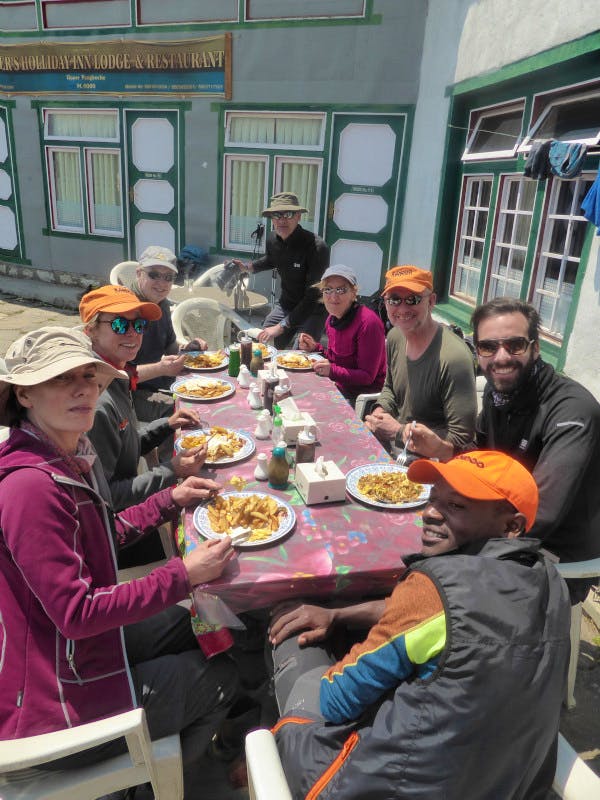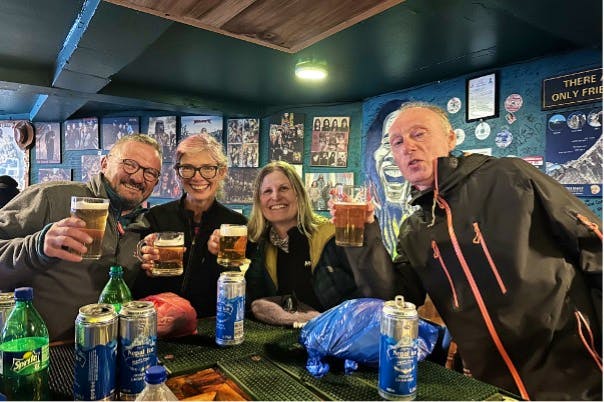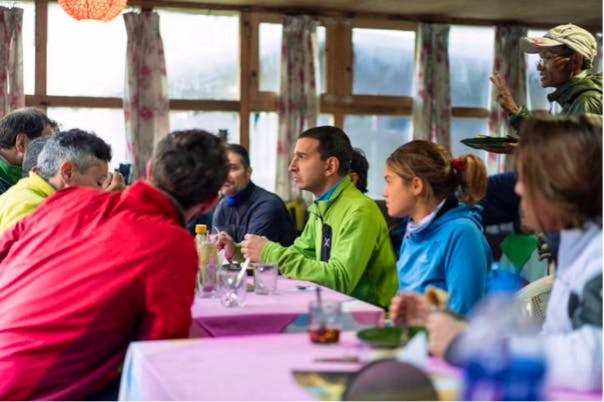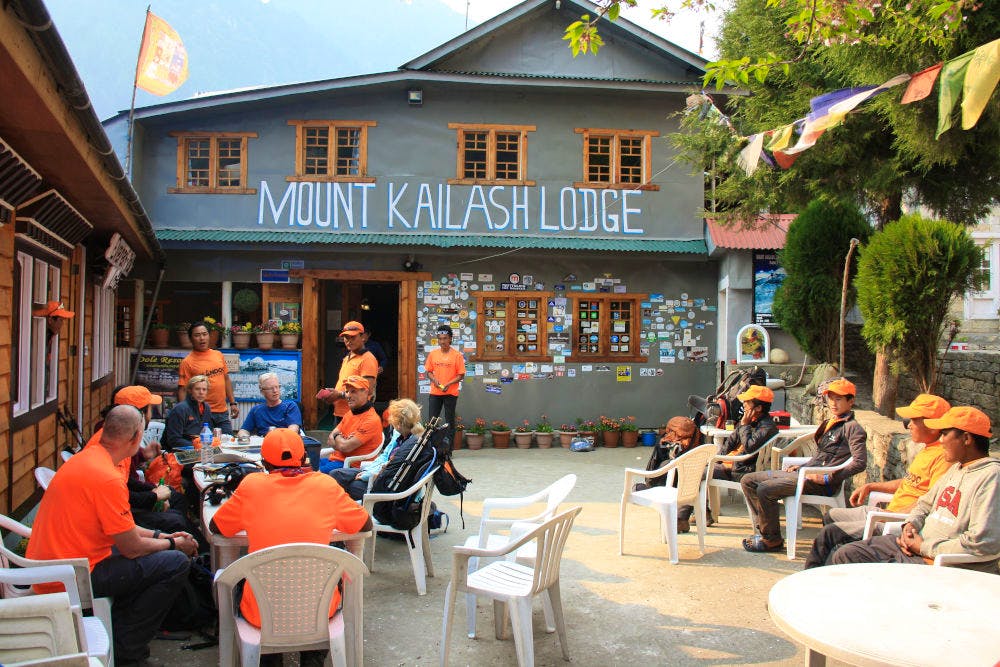Food On The Everest Base Camp Trek: What To Expect
Food on the Everest Base Camp Trek
Breakfast Options
Common Breakfast Foods
Porridge/oats: A warm bowl of oat porridge is a classic start to a chilly Himalayan morning. It’s rich in fibre and keeps you full for longer.
Toast varieties: Whether it’s plain toast or toast with eggs, jam, honey, or even cheese, you’ve got options. It’s a quick and easy way to get some carbs into your system.
Eggs: Boiled, scrambled, or in an omelette—eggs offer the protein you’ll need for those strenuous climbs.
Tibetan pancakes: A local delicacy, these are thicker than your average pancake and offer a unique taste of the region.
Tea/coffee: A hot beverage is essential for waking you up and keeping you hydrated.
Importance of a Hearty Breakfast

Lunch to Keep You Going
Typical Lunch Options
Dal bhat: This traditional Nepali dish is a powerhouse of nutrition. It includes rice, lentil soup, and various vegetable curries. Sometimes, it comes with a side of pickled vegetables or meat curry.
Fried rice: Whether it’s veggie, egg, or even chicken fried rice, this dish is a quick source of energy that’s both filling and delicious.
Noodle dishes: From Chow Mein to Thukpa (a local noodle soup), noodles are popular. They’re easy to digest and provide the carbs you need.
Sandwiches: For those who prefer a taste of home, grilled sandwiches with various fillings like cheese, egg, or even tuna are available.
Local soups: Garlic soup is a local favourite for its taste and supposed benefits in helping with altitude sickness.
Timing and Why It’s Crucial

Dinner: The Final Frontier
Common Dinner Foods
Dal bhat: Yes, it’s back! This staple is often served for dinner as well, but sometimes with a twist—like a side of fried fish or a different type of lentil soup.
Pasta dishes: From spaghetti to macaroni, pasta is a popular dinner choice. It’s filling and provides the carbs you’ll need to replenish your energy.
Momos: These Tibetan dumplings are a dinner favourite. Stuffed with meat or vegetables, they’re a tasty way to end the day.
Sherpa stew: This local dish is warming and filling, a mix of vegetables and meat in a hearty broth.
Pizza: Believe it or not, pizza is available at some tea houses. It’s a comforting taste of the familiar in an unfamiliar landscape.
How Dinner Differs from Other Meals
What to do if you have Dietary Requirements?

Vegetarian and Non-Vegetarian Options
Vegetarian: The good news is that many traditional Nepali dishes, like Dal Bhat, are naturally vegetarian. You’ll also find a variety of vegetable-based dishes like vegetable curry, fried rice, and even vegetarian momos.
Non-vegetarian: While meat options are available, it’s essential to note that as you ascend, the freshness of meat can become questionable. However, dishes like chicken curry and fish are often on the menu at lower altitudes.
Special Dietary Needs
Gluten-free: While the menu may not explicitly list gluten-free options, dishes like rice and lentil soup are naturally gluten-free. Always double-check with the tea house to ensure no cross-contamination.
Vegan: Vegan options are limited but possible to find. Lentil soup, vegetable curries, and rice are your best bets. Again, confirming with the tea house that no ghee or butter is used in the preparation is a good idea.
Nut allergies: Nut-based dishes are uncommon, but it’s always better to specify your allergy to the tea house staff.
Lactose intolerance: Dairy is commonly used in Nepali cuisine, especially in tea and some desserts. Make sure to ask for dairy-free alternatives where possible.

Local vs International Cuisine: A Culinary Journey From the Himalayas to Home
Availability of Local Nepali Dishes
Dal bhat: This dish is the cornerstone of Nepali cuisine and is available at almost every tea house you’ll encounter.
Momos: These delicious dumplings are a must-try, often filled with either vegetables or meat.
Thukpa: This hearty noodle soup is a Tibetan dish that has found a home in Nepali kitchens. It’s incredibly comforting in the cold mountain air.
Sherpa stew: Named after the famed mountain community, this stew is a mix of meat and vegetables, perfect for warming you up after a long day.
Where to Find International Cuisine
Pasta and pizza: Surprisingly, Italian dishes are quite popular in the tea houses. They’re a comforting alternative if you’re craving something familiar.
Sandwiches: From tuna to grilled cheese, sandwiches offer a quick and easy Western meal option.
Chinese dishes: You’ll often find fried rice and noodle dishes that are more Chinese-inspired than authentically Nepali.
Bakeries: In some larger villages like Namche Bazaar, you’ll find bakeries offering pastries and even apple pie!

Freshness and Hygiene: How Does it Work?
How Freshness Is Maintained
Local produce: Many tea houses use locally sourced vegetables and herbs, ensuring the ingredients are as fresh as possible.
Limited meat: As you ascend, you’ll notice fewer meat options on the menu. This is because storing meat safely at higher altitudes becomes increasingly challenging.
Daily preparation: Food is often prepared daily to ensure its freshness. Leftovers are rarely, if ever, served to guests.
Hygienic Practices in Food Preparation
Boiled water: Whether for cooking or making tea, water is always boiled to kill harmful bacteria.
Clean utensils: Utensils are thoroughly cleaned and often boiled to ensure they are germ-free.
Trained staff: The staff at tea houses are trained in basic food hygiene, including the importance of washing hands and using clean utensils.
Food storage: Ingredients are stored in sealed containers to protect them from contamination and pests.
Conclusion
More EBC Articles
Popular EBC Trips
Find your next adventure
Why Skyhook?
Join over 27,000 Skyhook adventurers who've used our platform to book directly with our vetted local guides, at local prices (we never markup).
Expert Local Guides
Experienced local guides, handpicked by us.
Best Prices
Never pay a markup on the local guide's price.
Exclusive Club
Earn loyalty rewards every time you travel.
Great Social Vibes
Small group tours provide a richer experience.
Stellar Feedback
Over 2,800 reviews, average of 4.9/5 stars.












